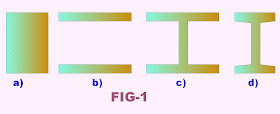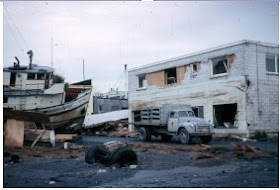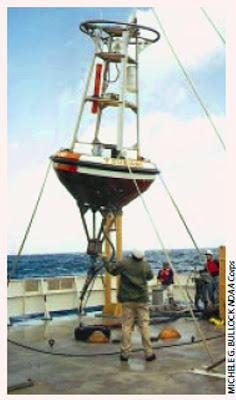Disintegration of concrete and corrosion of reinforcement is the sign of deterioration of marine concrete structure. Many researchers have identified, after laboratory investigation and extensive studies on existing marine structures, a number of factors affecting the deterioration of reinforced concrete in such an aggressive environment. Some of these important parameters are stated below:
1) Aggregate Type
The properties and proportion of constituent materials of concrete have a large influence on the durability of concrete. As the aggregates occupy up to 80% by volume of concrete, the resistance surface properties of the aggregates are important parameters affecting durability of concrete. To ensure adequate durability of marine structure, the aggregates material should be dense, non shrinking and alkali resistant.
2) Cement Content
The cement content also has a marked influence on the durability of reinforced concrete. Several researchers and authorities have been given recommendation for the minimum cement content of concrete exposed to different zone of marine environment.
3) Water-Cement (W/C) Ratio
- 0.45 in case of curbs, gutter, guard rail or their sections and
- 0.50 for other elements.
4) Cement Type
The resistance of concrete against the action of various aggressive agencies depends to a great extent on the type and proportion of cement. Ordinary Portland and pozzolana and sulfate resisting cement are the various types mainly used in marine concrete construction. Various researchers assessed the performance of these cements individually by either exposing the mortar and concrete specimens in the seawater or in its constituent salt solution, to study their strength and durability characteristics.
5) Air Entrainment
Harden concrete containing entrained air is more uniform, has less absorption and permeability and is more resistant to the action of freezing and thawing. Normally, about 4-6% of air by volume of concrete is entrained which is dispersed throughout, the concrete in the form of minute, disconnect bubble. It has been reported that the amount of entrained air necessary for imparting the highest resistance to concrete to frost action in the seawater is in the range of 10-20% which is more then twice as large as concrete with 3-6% air entrained when exposed to plain water in similar environment. However, the amount of air entrained 10-20% reduces the compressive strength of concrete to about one-half of the strength without air entrainment.
6) Carbonation Process
The hydrated concrete has a tendency of combining with carbon dioxide, CO2 present in the atmosphere and forming carbonates, which partly neutralizes the alkaline nature of concrete. This process is known as carbonation. When carbonation depth exceeds depth of cover to the reinforcement, the salt ions find a suitable environment leading to greater corrosion.
7) Quality of Mixing Water
Sea water contains a total 3.5% salinity of which
- 78% is NaCl ( i.e. 2.7% of total salinity)
- 15% is MgCl2 and MgSO4
According to ACI 318-83 the mixing water should be potable and free from salts. Giving no specific reference to sea water, it specifies that mortar cubes made with computable mixing water shall 7 days and 28 days strength equal to at least 90% of strength of similar specimen made with potable water.
7) Influence of Crack
Reinforced concrete structure, either reinforced develop unavoidable cracks during their service life. Cracking may stem from various causes; construction cracks as a result of initial and drying shrinkage, settlement, and heat of hydration; load cracking during normal service as a result of flexure, stress reversal, torsion, shear etc. However cracks offer a path to the interior of concrete for the deactivating and corroding agents.
8) Depth of Cover to the Reinforcement
The thickness of the concrete cover to the steel is an important factor regarding rebar corrosion in an aggressive environment. It affects the time taken for the salts to penetrate to the steel, and the subsequent rate of arrival of oxygen at the steel surface as in the case of permeability. Lesser the cover, shorter the time required to deactivate the embedded steel. Also moisture content of the cover, defines permeability to surrounding salts and gases.
9) Age of Immersion
The age of immersion also referred to, as period of procuring is the time duration of concrete commencing immediately after casting up to the formal curing. In a marine environment, procuring of concrete can be done with either sea water of fresh water. The dissolved salts start reaching with the concrete affecting its rate of gain in strength when procuring is done with seawater.
10) Diffusion of Salts Under Pressure
The harmful salt ions enter to the body of concrete at various depths under hydrostatic pressure and also to the embedded steel. This result disintegration of concrete which in turn increase its permeability and provides greater accesses to the chloride ions for coming in contact with steel. But due to limited availability of oxygen, the corrosion process is often ineffective.
11) Wetting and Drying Cycles
In marine environment, the structural concrete in tidal zone undergoes alternate wetting and drying process due to tidal action.
12) Freezing and Thawing Cycle
Concrete is greatly affected freeze-thaw cycles. The change in physical state of water ( liquid-solid) inside the mass of concrete results in an increase of volume 9%. The volume change in a cyclic fashion (freeze-thaw cycle) causes disruption of concrete by dilution process.
1) Aggregate Type
The properties and proportion of constituent materials of concrete have a large influence on the durability of concrete. As the aggregates occupy up to 80% by volume of concrete, the resistance surface properties of the aggregates are important parameters affecting durability of concrete. To ensure adequate durability of marine structure, the aggregates material should be dense, non shrinking and alkali resistant.
2) Cement Content
The cement content also has a marked influence on the durability of reinforced concrete. Several researchers and authorities have been given recommendation for the minimum cement content of concrete exposed to different zone of marine environment.
3) Water-Cement (W/C) Ratio
The water-cement ratio influences both the strength and durability of concrete. According to Abram’s Law, the strength of concrete at a given age and normal temperature decrease with increasing the water-cement ratio assuming full compaction of concrete have been done. Permeability of concrete to water depends mainly on the W/C ratio, which determines the size, volume and continuity of the capillary voids. It is clear that even a small increase of W/C ratio can increase the concrete permeability to a great extent. Again, permeability is the most important Characteristics determining the long-term durability of reinforced concrete exposed to seawater as it controls the diffusion of aggressive salt-ions into the concrete. ACI 318-83 requires that normal –weight concrete subjected to freezing and thawing in a moist condition should have a maximum W/C ratio of:
- 0.45 in case of curbs, gutter, guard rail or their sections and
- 0.50 for other elements.
4) Cement Type
The resistance of concrete against the action of various aggressive agencies depends to a great extent on the type and proportion of cement. Ordinary Portland and pozzolana and sulfate resisting cement are the various types mainly used in marine concrete construction. Various researchers assessed the performance of these cements individually by either exposing the mortar and concrete specimens in the seawater or in its constituent salt solution, to study their strength and durability characteristics.
5) Air Entrainment
Harden concrete containing entrained air is more uniform, has less absorption and permeability and is more resistant to the action of freezing and thawing. Normally, about 4-6% of air by volume of concrete is entrained which is dispersed throughout, the concrete in the form of minute, disconnect bubble. It has been reported that the amount of entrained air necessary for imparting the highest resistance to concrete to frost action in the seawater is in the range of 10-20% which is more then twice as large as concrete with 3-6% air entrained when exposed to plain water in similar environment. However, the amount of air entrained 10-20% reduces the compressive strength of concrete to about one-half of the strength without air entrainment.
6) Carbonation Process
The hydrated concrete has a tendency of combining with carbon dioxide, CO2 present in the atmosphere and forming carbonates, which partly neutralizes the alkaline nature of concrete. This process is known as carbonation. When carbonation depth exceeds depth of cover to the reinforcement, the salt ions find a suitable environment leading to greater corrosion.
7) Quality of Mixing Water
Sea water contains a total 3.5% salinity of which
- 78% is NaCl ( i.e. 2.7% of total salinity)
- 15% is MgCl2 and MgSO4
According to ACI 318-83 the mixing water should be potable and free from salts. Giving no specific reference to sea water, it specifies that mortar cubes made with computable mixing water shall 7 days and 28 days strength equal to at least 90% of strength of similar specimen made with potable water.
7) Influence of Crack
Reinforced concrete structure, either reinforced develop unavoidable cracks during their service life. Cracking may stem from various causes; construction cracks as a result of initial and drying shrinkage, settlement, and heat of hydration; load cracking during normal service as a result of flexure, stress reversal, torsion, shear etc. However cracks offer a path to the interior of concrete for the deactivating and corroding agents.
8) Depth of Cover to the Reinforcement
The thickness of the concrete cover to the steel is an important factor regarding rebar corrosion in an aggressive environment. It affects the time taken for the salts to penetrate to the steel, and the subsequent rate of arrival of oxygen at the steel surface as in the case of permeability. Lesser the cover, shorter the time required to deactivate the embedded steel. Also moisture content of the cover, defines permeability to surrounding salts and gases.
9) Age of Immersion
The age of immersion also referred to, as period of procuring is the time duration of concrete commencing immediately after casting up to the formal curing. In a marine environment, procuring of concrete can be done with either sea water of fresh water. The dissolved salts start reaching with the concrete affecting its rate of gain in strength when procuring is done with seawater.
10) Diffusion of Salts Under Pressure
The harmful salt ions enter to the body of concrete at various depths under hydrostatic pressure and also to the embedded steel. This result disintegration of concrete which in turn increase its permeability and provides greater accesses to the chloride ions for coming in contact with steel. But due to limited availability of oxygen, the corrosion process is often ineffective.
11) Wetting and Drying Cycles
In marine environment, the structural concrete in tidal zone undergoes alternate wetting and drying process due to tidal action.
12) Freezing and Thawing Cycle
Concrete is greatly affected freeze-thaw cycles. The change in physical state of water ( liquid-solid) inside the mass of concrete results in an increase of volume 9%. The volume change in a cyclic fashion (freeze-thaw cycle) causes disruption of concrete by dilution process.












 If the area of a beam of rectangular section [fig-1(a)] is arranged so as to keep the same overall depth but have the shape shown in [fig-1(b)], the moment of inertia
would be greatly increased, resulting in a greater moment resisting capacity. Actually, the increase in resisting moment is due to more fibers being located at a greater distance from the neutral axis. These fibers carry a greater stress and have a larger moment arm about the neutral axis to resist the applied bending moment. But, the section in [fig-1(b)] is not practical; the two parts of it would collapse together. It is necessary to use some of the area to fix these parts in place relative to each other, [fig-1(c)]. The web area transmits practically all the vertical shear.
If the area of a beam of rectangular section [fig-1(a)] is arranged so as to keep the same overall depth but have the shape shown in [fig-1(b)], the moment of inertia
would be greatly increased, resulting in a greater moment resisting capacity. Actually, the increase in resisting moment is due to more fibers being located at a greater distance from the neutral axis. These fibers carry a greater stress and have a larger moment arm about the neutral axis to resist the applied bending moment. But, the section in [fig-1(b)] is not practical; the two parts of it would collapse together. It is necessary to use some of the area to fix these parts in place relative to each other, [fig-1(c)]. The web area transmits practically all the vertical shear.


















